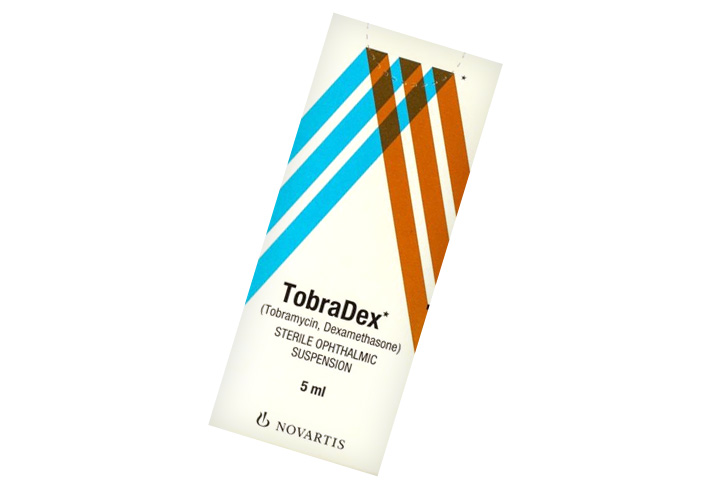Tobradex
TobraDex ophthalmic suspension contains the active ingredients tobramycin (antibiotic) and dexamethasone (glucocorticoid with anti-inflammatory action) and is used to treat certain inflammations of the eye accompanied by a bacterial eye infection.
What Does Tobradex Contain?

Active ingredients
1 ml of ophthalmic suspension contains 1.0 mg dexamethasone, 3.0 mg tobramycin.
Excipients
This medicine contains 0.1 mg benzalkonium chloride per ml of solution. Other excipients are: tyloxapol, edetate disodium, sodium chloride, hydroxyethyl cellulose, sodium sulphate, sulphuric acid and/or sodium hydroxide, purified water.
Forms and Strengths
Presentation: 5 ml bottle.
Uses
Adults
The dosage of the medicine must be determined by the doctor individually for each patient. Strictly adhere to the dosage and duration of treatment prescribed by your doctor, and never change it without consulting your doctor. Do not interrupt treatment without medical authorisation. In the event of swelling of the trunk and face (Cushing's syndrome) and/or extreme loss of strength, nausea and persistent diarrhoea (symptoms of adrenal suppression), you should not stop treatment abruptly, but reduce it gradually, as instructed by your doctor, until it is stopped completely.
If too much TobraDex ophthalmic suspension gets into your eye, rinse it out with lukewarm water. Do not apply any more drops until the next scheduled use.
To supplement treatment with TobraDex ophthalmic suspension, your doctor may prescribe TobraDex ophthalmic ointment (which is best used in the evening, before bedtime).
Children and adolescents
The use and safety of TobraDex ophthalmic suspension have not yet been established for children and adolescents.
Additional information
Shake the bottle well before use. To avoid microbial contamination of the ophthalmic suspension, ensure that the dropper in the bottle does not come into contact with your hands or eyes or with any object whatsoever. Close the bottle immediately after instillation and keep it tightly closed at all times.
After opening the bottle, remove the detached safety ring before using the ophthalmic suspension for the first time.
Side Effects
The use of TobraDex ophthalmic suspension may cause the following side effects:
Occasional (occurs in 1 to 10 out of 1000 users)
Increase in intraocular pressure, eye pain, eye irritation, itching of the eye, eye discomfort.
Rare (affects 1 to 10 in 10,000 users)
Corneal inflammation, allergic reaction (e.g. itching or swelling of the eyelids), blurred vision, dry eyes, redness of the eyes, taste alterations.
If such symptoms occur, consult your ophthalmologist immediately.
The following side effects have been reported in post-marketing experience:
Swelling or redness of the eyelids, dilation of the pupil, increased tearing, hypersensitivity, dizziness, headache, nausea, stomach ache and rash, swelling of the face, itching, reactions on the skin (erythema multiforme).
Other side effects of the different active ingredients that may occur with TobraDex ophthalmic suspension:
Tobramycin
Corneal abrasion, reduced visual acuity, swelling of the conjunctiva, eye discharge, inflammation of the skin, loss of eyelashes, whitening of the skin, dry skin.
Dexamethasone
Conjunctivitis, visible corneal discolouration, sensitivity to light, foreign body sensation, abnormal sensations in the eye, crusting of the eyelid margin, irritation, glaucoma, ulcerative keratitis, reduced visual acuity, corneal erosion, drooping of the eyelid, hormonal changes, e.g. increased hair growth (particularly in women), muscle weakness and wasting, stretch marks on the skin, high blood pressure, irregular periods or no periods at all, changes in protein and calcium levels in the body, growth retardation in children and adolescents, and swelling of the trunk and face (Cushing's syndrome).
If you notice any symptoms that may be related to TobraDex ophthalmic suspension, consult your doctor immediately.
Precautions
- If you develop an allergic reaction such as itching of the eyes, swelling of the eyelids, redness of the eyes, or even generalised reactions such as redness of the skin, itching, papules on the skin, anaphylaxis and blisters on the skin, stop the treatment and consult your doctor. These allergic reactions may also occur during other treatments (topical or systemic) with the same type of antibiotic (aminoglycoside). If you are taking other antibiotics at the same time as TobraDex ophthalmic suspension, ask your doctor for advice.
- If you suffer or have previously suffered from a disease such as myasthenia gravis or Parkinson's disease, ask your doctor for advice. Antibiotics of this type may cause muscle weakness to worsen.
- Prolonged use of TobraDex ophthalmic suspension may cause fungal infections.
- In the presence of a purulent eye infection.
- Corticosteroids may mask, activate or aggravate an eye infection. TobraDex ophthalmic suspension may delay healing if used for a prolonged period. It may also cause an increase in intraocular pressure, leading to glaucoma. During treatment with TobraDex ophthalmic suspension, always remain under medical supervision and have your intraocular pressure measured regularly by your doctor.
- If the problems treated with TobraDex ophthalmic suspension worsen after 2-3 days of treatment or if new symptoms appear, consult your doctor immediately.
- If you suffer from diseases causing thinning of the tissues of the eye (cornea or sclera), local application of corticosteroids may cause perforation of the eye.
- If you are diabetic (particularly type I), there is a risk of cataract. The use of corticosteroids in diabetics increases the risk of early and rapidly progressive cataracts.
- If you develop swelling of the trunk and face (Cushing's syndrome), tell your doctor. This risk is particularly high in children or patients taking ritonavir or cobicistat.
- TobraDex ophthalmic suspension contains benzalkonium chloride, a preservative that can irritate the eyes and discolour soft contact lenses. Avoid contact with soft contact lenses. During treatment with TobraDex ophthalmic suspension, wait at least 15 minutes after application before reinserting your lenses.
- Benzalkonium chloride may also cause irritation to the eye, particularly in cases of dry eye or corneal disease (transparent layer on the front of the eye). Please consult your doctor if you experience any unusual sensation, burning or pain in the eye after using this medicine.
- Caution should be exercised when TobraDex ophthalmic suspension is used at the same time as a mydriatic (a medicine designed to dilate the pupil), as an increase in intraocular pressure cannot be ruled out with this combination.
- The use and safety of TobraDex ophthalmic suspension in children and adolescents have not yet been studied. Consequently, the use of TobraDex ophthalmic suspension is not recommended in children and adolescents.
- If several eye preparations are used, there should be an interval of at least 5 minutes between each administration. Eye ointments should be used last.
- Please inform your doctor or pharmacist if you are suffering from any other illnesses, if you are allergic or if you are already taking other medicines (even if you are self-medicating!)/you are taking or already use other medicines for internal or ocular use.
- As sight may be temporarily impaired after instilling TobraDex ophthalmic suspension, it is recommended that you wait until the symptom has disappeared before driving a vehicle or operating machinery.
When should Avelox not be taken?
Do not use TobraDex ophthalmic suspension in the presence of
- known or suspected hypersensitivity (allergy) to any of the substances in the medicinal product
- glaucoma
- an eye infection that cannot be treated with an antibiotic (e.g. certain viral diseases of the cornea or conjunctiva)
- tuberculosis of the eye
- an ulcer or lesion of the cornea (including after the removal of an uncomplicated foreign body)
- untreated ocular mycosis or parasitosis.
What else do you need to consider?
It is essential that your doctor check your eyes regularly throughout treatment with TobraDex ophthalmic suspension.
The antibiotic (tobramycin) contained in this medicine is not effective against all the micro-organisms that cause eye infections. Using the wrong antibiotic or the wrong dose can lead to complications. For this reason, never use this medicine without a doctor's prescription for the treatment of an illness other than the one you are suffering from, or for other people. In the event of a new infection occurring at a later date, do not use the ophthalmic suspension without consulting your doctor again.
Pregnancy and Breastfeeding
TobraDex ophthalmic suspension should not be used during pregnancy.
TobraDex ophthalmic suspension should not be used during breast-feeding. You should therefore either stop breast-feeding or discontinue treatment.



